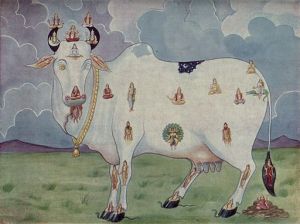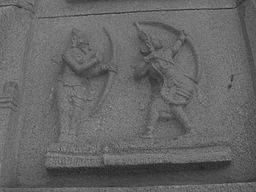
Kamadhenu is a cow who symbolizes fertility and creation in the Hindu belief system. I’ve found two alternate versions of her origins: in one, she’s the daughter of Rohini, the sun goddess, and in the other she’s the first being to emerge from the Sea of Milk after it’s been churned. (The churning of the Sea of Milk was in order to create amrita, the divine food that makes the gods immortal. So amrita is much like Idun’s golden apples, except that as far as I can tell the churning of the Sea of Milk was from the beginning the gods putting one over on the demons, rather than the tale of Idun’s abduction by Thiazi, where the gods deceiving the Jotunn only comes up late in the story…not that the Norse gods would ever be slow to kill a frost giant.)
Although the churning of the Sea of Milk is not a cosmogony, the Sea of Milk is the primal sea, so there may well be cosmogonic overtones, or at least hold-overs from some earlier cosmogonic tale. (Hm. Is that actually a word? Maybe the word is “cosmogonical”? No, that looks worse. Well, even if it’s not a word, it’s formed the right way from an actual word…)

An illustration from the Mahabharata. Wikimedia Commons.
One of my sources describes Kamadhenu as “the cow of plenty.” Presumably, since she’s from a Hindu tradition, that doesn’t mean that her meat can literally be carved out as many times as one wants and it’ll always grow back again. (Don’t laugh: Thor had goats that could do that. He’d have them killed, cooked and served, and as long as the bones weren’t damaged, he could bring them back to life again, fully-fleshed, the next day.) I’m not sure if her “cow of plenty” function meant she had an ability to make all plants in her vicinity grow to abundance, or if it just meant she could give a never-ending supply of milk.
In any case, no matter what function “cow of plenty” describes, I came across a Ugandan myth involving a magical cow with powers of plenty, though in this case I think they absolutely mean the ability to provide endless milk.
This Ugandan cow of plenty belonged to Kintu, the original (and, at that time, only) human. Eventually, Kintu fell in love with Nambi, the daughter of the sky god Gulu. Kintu asked for his beloved’s hand in marriage, but her father wasn’t eager to have a human son-in-law, and didn’t want to play fair about it, either. First, he stole Kintu’s magic cow and hid it among his own herds in the sky. If that was a test to see if Kintu could figure out what happened to his cow, Kintu failed it, because he just tried to live quietly and patiently without milk, until Nambi told him where his cow had gone.
When Kintu showed up in the sky to reclaim his cow, Gulu set him four tasks, each one impossible. Kintu was led to a hut filled with enough food for a hundred men and told to empty it by morning; when Kintu couldn’t eat it all, he dug holes in the floor and dumped the rest through the floor, letting it plummet back to earth, bringing life and fertility to the land and sea. The second task was to split rocks with a soft axe made of copper, but Kintu was able to use wooden wedges and water to split the rocks, using the axe as a hammer instead of as an axe. The third test was to fill up a bottomless water pot; Kintu used the clinging properties of dew to get around the inherent difficulties there. The last task was for Kintu to pick out his cow from the herd as it was driven past in front of him. Nambi didn’t wait to see if Kintu could do it; she turned into a bee and told her lover to choose the animals on whose horns she landed. Then she landed not only on the horns of Kintu’s cow, but also on the horns of the three calves the cow had given birth to during her time in the heavens.
Kintu won his bride, but he also won the unpleasant attentions of one of her brothers: Death, who started by hunting Kintu, and then continued to hunt his descendants ever after.
Most of that doesn’t actually tie in with Kamadhenu in the least, I realize, but once I started the story, I wanted to finish it.
Kamadhenu’s status as a cow with the power of fertility is reminiscent of Geush Urvan, a bull that embodied the power of the earth itself in ancient Iranian beliefs. It lived for three thousand years, only to be killed by Mithras. Once Geush Urvan was dead, the power that had once been housed in the earth passed the sky and the gods who lived there, while what little power remained in the bull’s body was broken down and made into all the plants and animals of the earthly realm. (It was because of his killing of the universal bull that the Mithraic ceremonies in Roman times always centered around the ritual slaughter of a bull, of course.)
From Geush Urvan we can get to another primal bovine, another cow this time. Specifically, Audumla, the second being ever to exist, according to the Norse story of creation.
Apparently, before there was life, there was the ice of Niflheim. From that ice emerged Ymir, the primal frost giant. He was soon followed by Auðumbla, a cow who must have been of quite prodigious size, because the primal frost giant — much larger than the garden-variety Jotunn of the later tales — was able to nourish himself by suckling directly at her teats. While she was thus feeding the first giant, Auðumbla was licking away at the ice, and eventually revealed Buri, who would go on to father Odin and his brothers. Eventually, Odin and his brothers slew Ymir (there’s a shock, right?) and the world was created from his corpse. (But I don’t know what happened to Auðumbla. Probably ended up in Odin’s stables…)
Okay, so that wasn’t so much “comparative cow mythology” as “a random collection of cow-related myths” but…okay, actually, I think I really like the term “comparative cow mythology.” I need to find a place to use that in a story. That’s fun.







You must be logged in to post a comment.